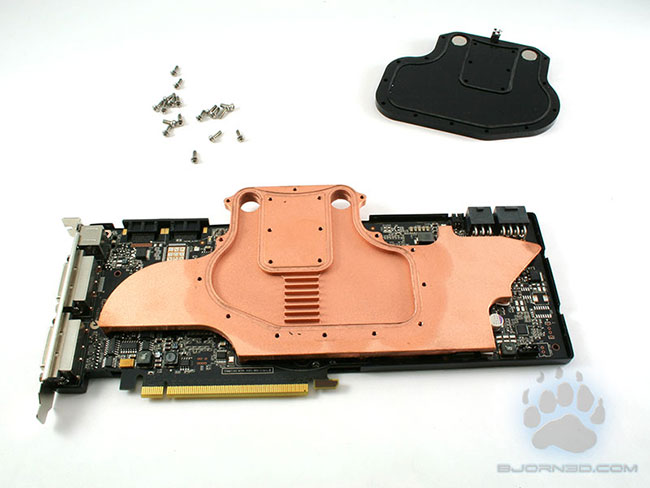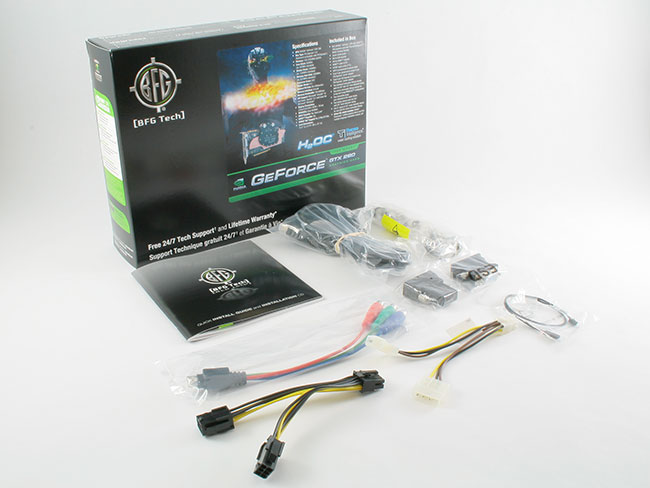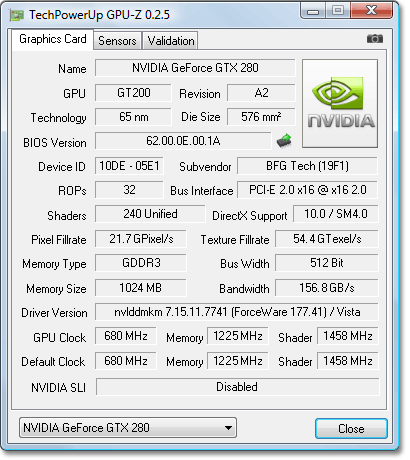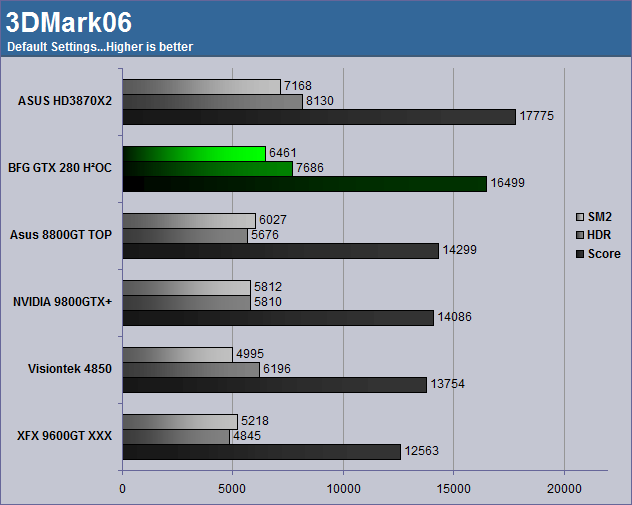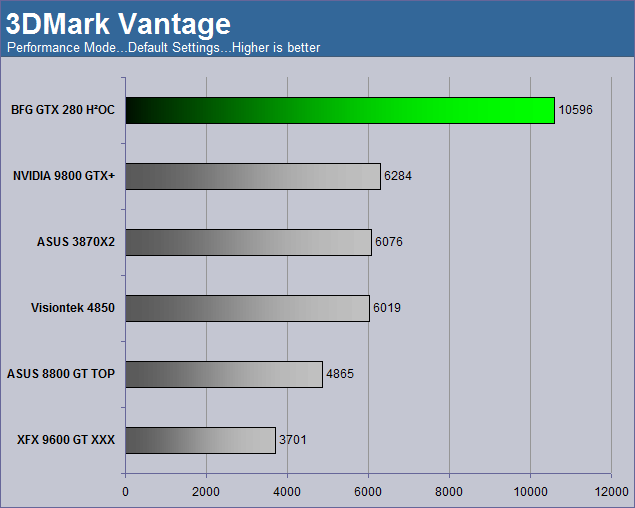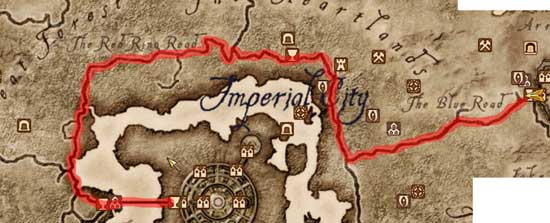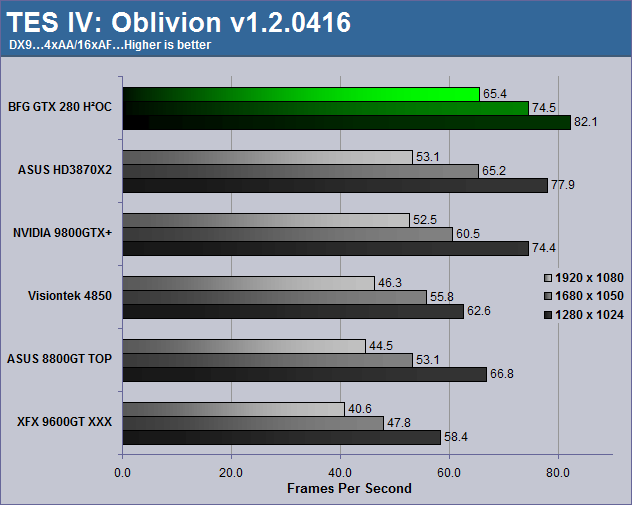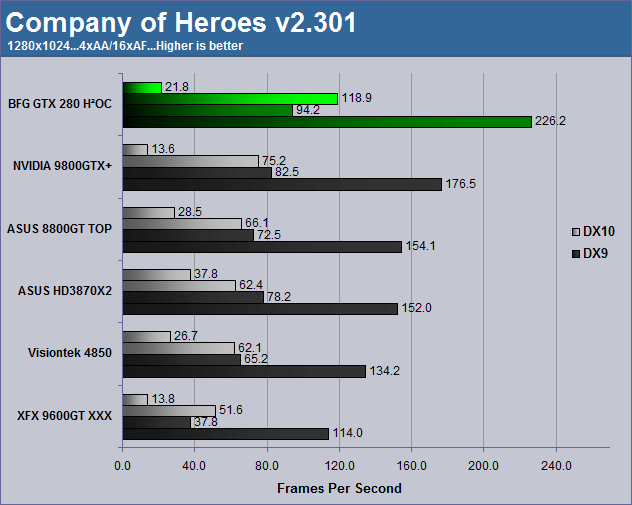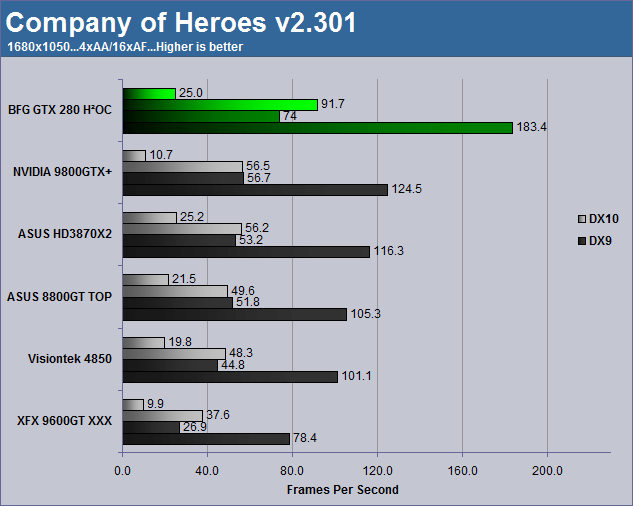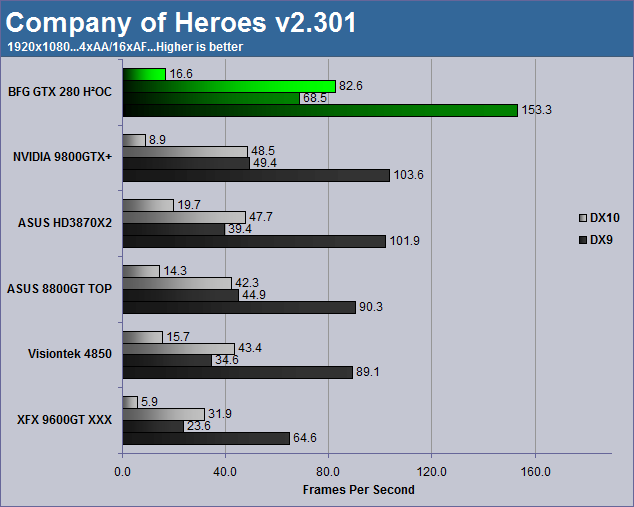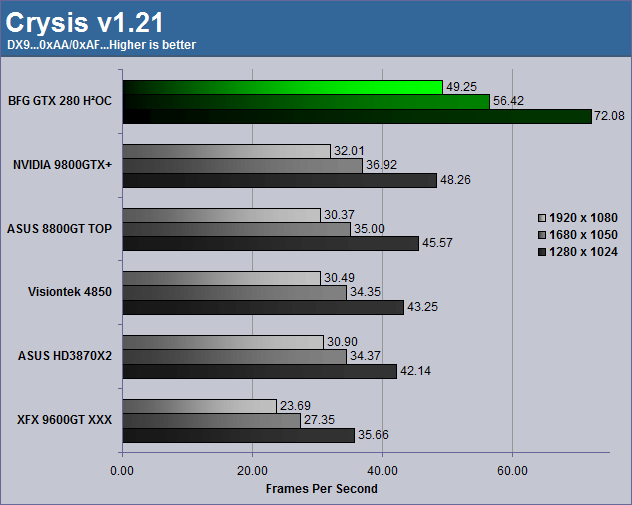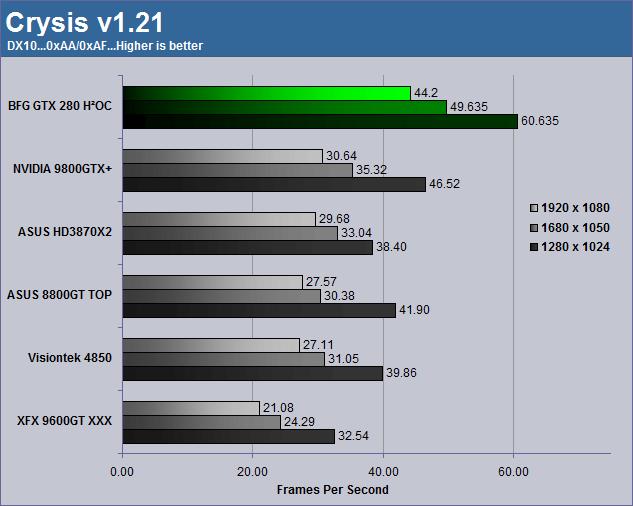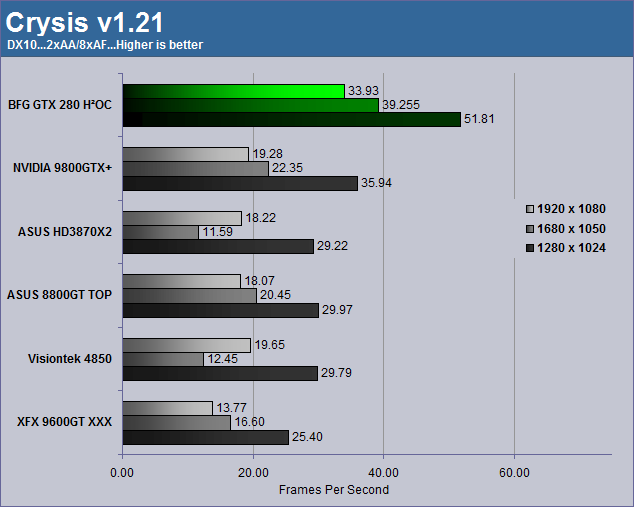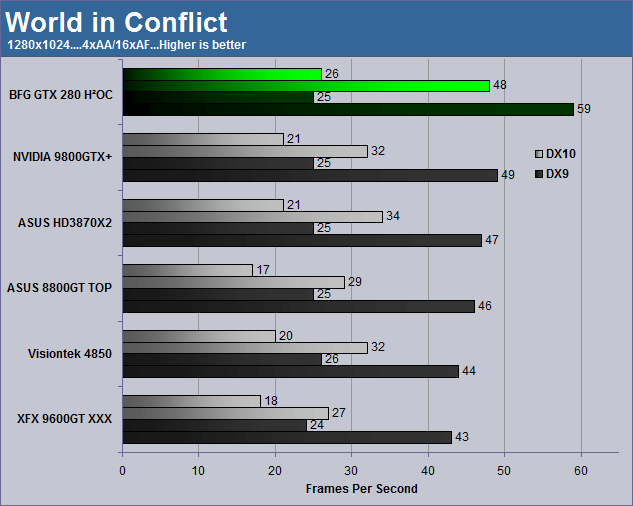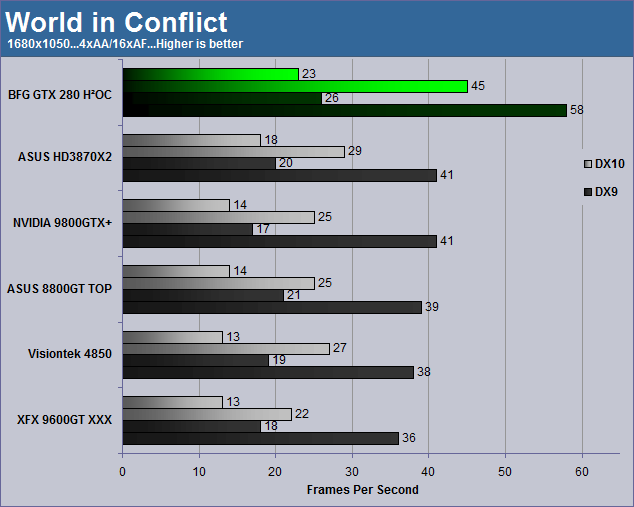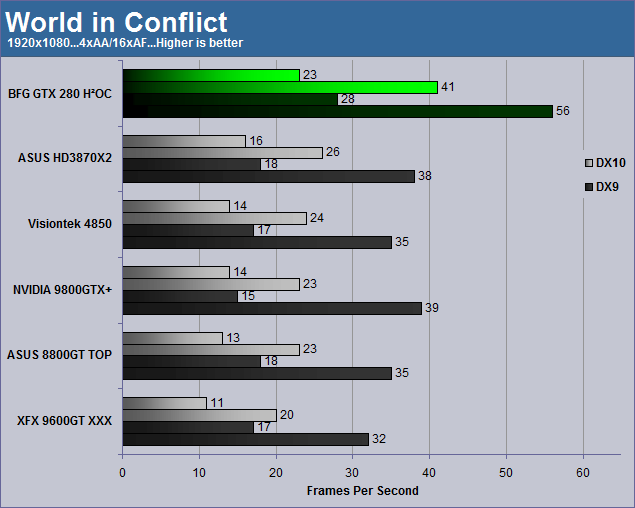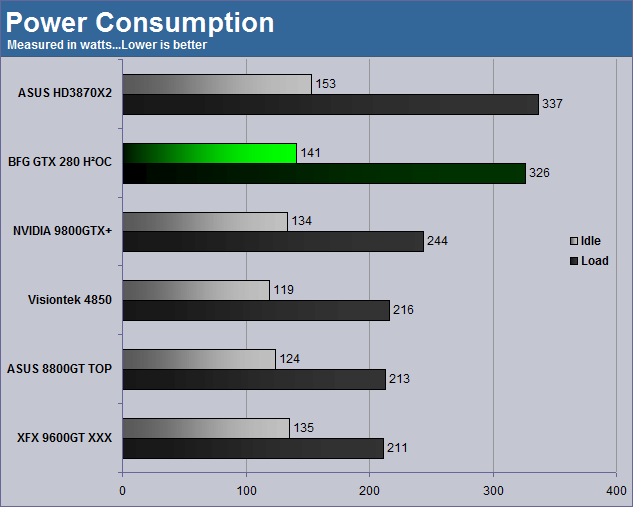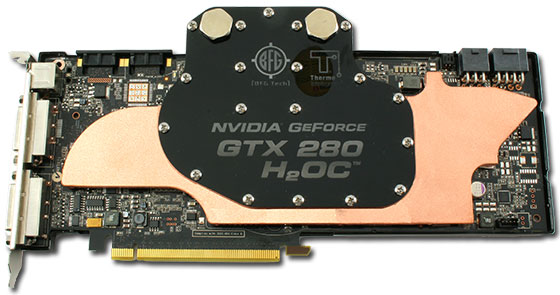BFG is back to show you just what it takes to make a card like GTX 280 run in a single slot. Combining the power of water cooling with some voodoo magic BFG is able to make the fastest single GPU card on the planet even faster! HOw much faster? Read on to find out.
INTRODUCTION
Today we have the distinct pleasure of looking at the results of the crazy minds over at BFG Tech, and some of their cutting edge technology. You see, the gang over at BFG is never satisfied; and personally, that’s the way we at Bjorn3D like it. Fast is never fast enough and there is always room for more – a great mantra when it comes to technology, though not so great when it comes to driving on the road.
Thankfully, the crazy engineers over at BFG aren’t allowed to leave the facility and must work on nothing other than creating the fastest cards around. The card we are speaking of today is none other than the GTX 280 H²OC edition from BFG. Fitted with the newest full-face water block from DangerDen and overclocked for good measure, this is one serious card. But underneath all of the copper and silicon lies a softer side, a greener side. You see this card doesn’t just churn out frames faster than anything you’ve ever seen before, it also likes to save you money by using less power while it’s not gaming. Read on to find out what other wonders this card holds and if it deserves a spot in your next build.
SPECIFICATIONS
| GPU Specifications | ||||
| BFG GTX280 H²OC | GTX280 | ATI 4850 | 9800GTX | |
| Fabrication Process | 65nm | 65nm | 55nm | 65nm |
| Transistor Count | 1.4 Billion | 1.4 Billion | 965 Million | 754 Million |
| Core Clock Rate | 680 MHz | 602 MHz | 625 MHz | 675 MHz |
| SP Clock Rate | 1,458 MHz | 1,296 MHz | – | 1,688 MHz |
| Streaming Processors | 240 | 240 | 800 | 128 |
| Memory Clock | 1,225 MHz (2,450 MHz) |
1,107 MHz (2,214 MHz) |
1000 MHz (2000 MHz) |
1100 MHz (2,200 MHz) |
| Memory Interface | 512-bit | 512-bit | 256-bit | 256-bit |
| Memory Bandwidth | 156.8 GiB/s | 141.7 GiB/s | 64.0 GiB/s | 70.4 GiB/s |
| Memory Size | 1024 MB | 1024 MB | 512 MB | 512 MB |
| ROPs | 32 | 32 | 16 | 16 |
| Texture Filtering Units | 80 | 80 | 40 | 64 |
| Texture Filtering Rate | 54.4 GigaTexels/s |
48.2 GigaTexels/s |
25.0 GigaTexels/s |
43.2 GigaTexels/s |
| RAMDACs | 400 MHz | 400 MHz | 400 MHz | 400 MHz |
| Bus Type | PCI-E 2.0 | PCI-E 2.0 | PCI-E 2.0 | PCI-E 2.0 |
| Power Connectors | 1 x 8-pin 1 x 6-pin |
1 x 8-pin 1 x 6-pin |
1 x 6-pin | 2 x 6-pin |
BFG takes a fast card and gives it a swift kick in the arse just for good measure. The H²OC is easily one of the fastest GTX 280s in existence today. For anyone who has a water cooling setup or is looking for a reason to go with water, you may just have the perfect upgrade. For those who wish to read about the architectural changes that took place with the GTX 280 please click HERE.
PACKAGING
BFG bundles the GTX 280 H²OC card in a protective cardboard casing within the outer shell shown below. This system worked well and the card arrived with no damage. The front of the box informs you about the lifetime warranty and free 24/7 tech support, while the back gives you an idea about the performance of the card in relation to integrated graphics. Not the best (or fairest) comparison in our opinion.
Click a picture to see a larger view
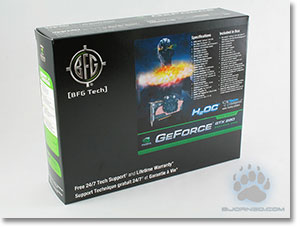 |
 |
| Box front | Box rear |
PHOTOS
The first photo in our series shows us the card and full-face, DangerDen-designed water block in all its glory. Covering all the major components, the copper water block with its lucite top is sure to keep this card cool. Looking at how thin this card is, I was astonished to see a GTX 280 card in a single slot format. With the amount of heat this beast puts out I would not have been surprised to see a water cooling block that took up an additional slot. For those wishing to run triple SLI and the intense heat that brings, this may be the only method for doing so safely.
Click a picture to see a larger view
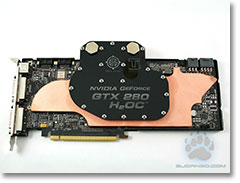 |
 |
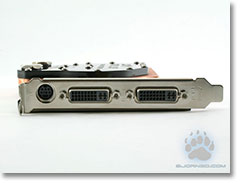 |
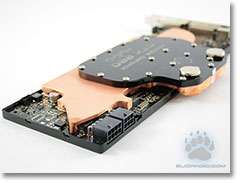 |
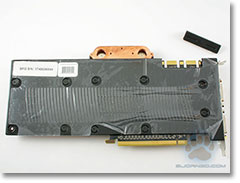 |
Turning to the back of the card we see the two power connectors responsible for keeping this card juiced up. Thankfully, as we’ll see below, BFG included adapters for both socket types (8-pin & 6-pin) so even if you have an older PSU that provides enough amps but lacks the proper connectors, you can still enjoy the bliss of gaming on the most powerful single GPU card to date.
When we flip the card over we see how BFG cools the memory modules on the back. Since finding room for 1024 MB worth of RAM on one side of the PCB is nigh impossible, we end up with eight chips on either side with the back plate providing passive cooling to the rear chips. Additionally, we see the same rubber SLI connector used to protect the contacts should you only be using one of the cards. Presumably while trying to sell your other arm and leg to afford another one.
Shown below is the water block with its top off. That’s right my friends, we have some topless action. Getting back on point, it is a straightforward design with the water channel flowing from one side to the next. The raised fins sit right atop the GPU to provide extra cooling capacity. I am a bit surprised these fins aren’t waved to provide more surface area, since straight fins would provide the least. I am certainly no expert on the matter but I thought it was worth pointing out.
CONTENTS
Anytime you have a card with the added complexity of water cooling you need to make sure you provide all the fittings and clamps necessary to accommodate a wide variety of enthusiasts. BFG does just that. They even go the extra mile by including an HDMI cable for those of you with some HDTV lovin’ or higher-end LCD monitors. The only thing missing from this bundle is a game. I know I am nitpicking here but for the cost of this card I would have liked to have seen a game, or at the very least, a voucher for a game as some other companies have started providing. A voucher would allow me to select the game of my choice, which in my mind provides infinitely more value than a bundled game I may already have, or simply do not want.
- Driver CD
- HDMI cable
- Fittings for various tube sizes (1/4, 3/8, 1/2)
- 1x DVI-VGA adapter
- 1x DVI-HDMI adapter
- 1x 8-pin adapter
- 1x 6-pin adapter
- Component cable Adapter
- User manual
TEST SETUP
All tests were conducted on the following platforms. A format of the hard drives followed by a fresh install of the OS was done. The latest drivers were then installed and all non-essential applications were halted.
| Test Platform | |
| Processor | Intel QX9650 @ 3.5GHz |
| Motherboard | XFX 790i Ultra |
| Memory | 2 GB (2 x 1 GB) Mushkin DDR3-2000 |
| Drive(s) | 1 – Seagate 80GB Barracuda SATA 1 – Samsung HD501LJ SATA |
| Graphics | Card 1 – BFG GTX 280 H²OC Card 2 – Visiontek HD4850 Card 3 – ASUS EAH 3870X2 Card 4 – ASUS 8800GT TOP Card 5 – XFX 9600GT XXX Card 6 – NVIDIA 9800 GTX+ |
| Drivers | Forceware 177.41 – BFG GTX 280 Forceware 175.19 – 9600 GT, 8800 GT, 9800 GTX+ Catalyst 8.6 – 3870X2 Catalyst 8.7 beta – HD 4850 |
| Sound | On board |
| Cooling | Big Typhoon VX |
| Power Supply | OCZ GameXStream 850 watts |
| Display | Westinghouse 37″ LVM-37W3 |
| Case | No case |
| OS | Windows Vista Ultimate 32-bit SP-1 |
All cards will be tested using a variety of games. For Crysis, we will be testing the game both without any image enhancements and then again with 2x Anti-Aliasing and 8x Anisotropic Filtering. All other games will be tested with 4x AA and 16x AF. The resolutions tested are 1280×1024, 1680×1050 and finally 1920×1080.
OVERCLOCKING
The added complexity that comes with water cooling also brings with it a few advantages. Because water is able to hold a higher capacity of heat in the same volume of air, it is more efficient at removing heat. It is this trait of water that allows users to enjoy lower temperatures, increased overclocking headroom, or both! First let’s take a look at our stock settings, which are already overclocked from the default factory settings.
Stock
Overclocked
Excellent results! The BFG GTX 280 H²OC overclocks like a champ and even if you wanted to keep the card at its “stock” settings for warranty purposes, you can rest assured you’re getting one of the highest clocked GTX 280s on the market. Now it’s time to see what these speeds offer us in the way of performance.
TEST RESULTS
3DMark2006
An old favorite of benchmarkers. 3DMark 2006 is a fun tool to have if you want to brag to your friends, but when it comes to representing real world performance it falls far short of the mark. We include the scores here only to be thorough.
3DMark Vantage
The newest video benchmark from the gang at Futuremark. This utility is still a synthetic benchmark but one that more closely reflects real world gaming performance. While it is not a perfect replacement for actual game benchmarks, it has its uses. We test our cards at the ‘Performance’ setting as this will be the most widely used setting.
Currently there is a lot of controversy surrounding NVIDIA’s use of a PhysX driver for its 9800 GTX and GTX 200 series cards. Whereby installing the PyhsX driver, 3DMark Vantage uses the GPU to perform PhysX calculations during a CPU test and this is where things get a bit gray. If you look at the Driver Approval Policy for 3DMark Vantage it states that:
Based on the specification and design of the CPU tests, GPU make, type or driver version may not have a significant effect on the results of either of the CPU tests as indicated in Section 7.3 of the 3DMark Vantage specification and white paper.
Did NVIDIA cheat by having the GPU handle the PhysX calculations, or are they perfectly within their right since they own Ageia and all their IP? I think this point will quickly become moot once Futuremark releases an update to the test. For now, we will show ONLY the GPU score, since this is much less influenced by the inclusion of PhysX.
The Elder Scrolls IV – Oblivion v1.2.0416
We test Oblivion by using a manual run through and record our performance using FRAPS. I start outside the town of Cheydinhal on horse back, and taking the same route each time, I travel to the Imperial City. The trip takes a full six minutes and encompass’ long view distances, water, forests, Oblivion gates and NPCs. Being such a long trip, any changes from one run to the next (e.g. a wandering NPC) would have an effect equal to or less than 1% on frame rate. This method gives me great insight into the real world performance of each card tested.
All settings are maxed out and we use bloom lighting for our tests.
The BFG GTX 280 H²OC performs very well here but really starts to shine at the higher resolutions. At 1920×1080 the GTX 280 is 23% faster than its nearest competitor, the 3870X2 and reaches the all important 60+ frames per second mark.
TEST RESULTS
Company of Heroes v2.301
For our CoH testing we ran the game using the DirectX 9 path and then again using the DirectX 10 path. Both runs were completed using the exact in-game settings, so the only difference to be noted is the render path used. In each of our graphs below DX 10 is on top, and the DX 9 score is directly underneath it. Both minimum and average scores are shown for each setting.
Once again we see the H²OC flexing its processing muscle at the higher resolutions. Once we get above 1680×1050 (standard 22″ widescreen) we really notice a difference. This is important for those who may have a 19″ standard aspect ratio monitor (4:3) and are considering the GTX 280 as an upgrade.
Crysis v1.21
Similar to CoH, Crysis is run in both DX 9 mode as well as DX 10. All settings were kept the exact same with the exception being which DirectX level was used.
BFG continues its dominance with its GTX 280. Even Crysis is starting to come under pressure as more powerful GPUs enter the market. At 1680×1050 we noticed an odd phenomena that occured only on ATI based GPUs. With DirectX 10 enabled and running with 2x Anti-Aliasing and 8x Anisotropic Filtering, we observed a drastic drop in the frame rate. Since this does not occur with AA and AF disabled, we can safely conclude it is a driver issue and will stay on top of this for a fix.
World in Conflict
For World in Conflict we do things a bit differently. Both DX 10 and DX 9 were tested but this time for DX 10 we enabled the extra setting that is only available by using DirectX 10, Volumetric Light (aka God Rays).
TEST RESULTS
Power
Here is where we separate the men from the boys. Sure, you’ve seen all the great performance this card has to offer, but at what cost does it come? Will you need to refinance that home of yours to keep gaming for a few more months or will solar power be enough to keep you in the game? Power levels shown below are for the entire system sans monitor.
- CPU: QX9650 @ 3.5 GHz 1.35v
- MOBO: XFX 790i Ultra
- RAM:2 GB (2x1GB) DDR3-2000 1.9v
Shown here is the power usage at idle and load. Idle is measured after a period of fifteen minutes with no running applications. Load is measured during Company of Heroes and taken at the highest observed point during the benchmark. The GTX 280 does exceptionally well here at idle and kudos should be given to NVIDIA for addressing the problem of having a high-end GPU while web surfing. Of course, as shown by our load numbers, it is clear this beast chews up power by the boat load.
One thing to mention here is that since we are dealing with a water cooled card, we have more stuff using power like the water pump and two extra fans for the radiator. For those who are interested, I unplugged the pump and fans and took a measurement as soon as it stopped fluctuating, and was able to record an idle power consumption of 128 watts. This also tells us that our pump and two fans are using 13 watts to cool the card. Speaking of cooling the card, let’s see how effective the water cooling solution is.
Temp
Now that we have an idea about what kind of power the BFG GTX 280 H²OC draws, we can see just how effective its DangerDen water block is. The equipment used in the water loop is a Laing DDC-1TP pump with a Petra top, Swiftech MCR-220 Rad with two Noctua NF-P12 fans in push configuration, a Swiftech Micro-Res, and 1/2″ ID Tygon tubing. The GPU is the only block in the loop.
The loop is configured as: Pump->Rad->GPU->Res->Pump.
Idle temps were taken after a 15 minute period of sitting at the desktop with no open windows. Load temps were recorded by using ATiTool 3D view to place a constant load on the card.
| Temperature | |
| Idle | Load |
| 47 | 63 |
The water block does a fantastic job at cooling the 1.4 billion transistors of the GTX 280. The GPU isn’t the only thing creating heat, as the memory chips themselves also serve to warm up the back side of the card. The GTX 280 is one card that craves an aftermarket cooling solution and BFG is more than happy to oblige. The DangerDen designed water block performs very well, though I would hesitate using a lower end water cooling kit unless it only serves the GPU. Adding the heat from a CPU into the loop of a lower end loop could overwhelm the radiator and cause both components to run warmer than expected.
WARRANTY
BFG Tech. warrants their card will be free from defects in material and workmanship under normal use during the warranty period. What is the warranty period you ask? You get a lifetime of coverage from the time of purchase. That is, as long as your a resident of North America. If you live outside of this area BFG still has plenty of love for the rest of you by offering a ten year warranty. Not too shabby though it makes me wonder what the rest you non-Americans are using your cards for that result in an increased number of damaged cards/warranty returns. The only catch to all of this is the fact that you will need to register the card with BFG’s web-site within thirty days of purchase. If you fail to register the card in time BFG will extend a one year warranty for US customers and two years for the European lot of you.
CONCLUSION
The GTX 280 H²OC from BFG is a solid performing card that takes a good thing and makes it better. With 1.4 billion transistors and a gigabyte of video memory the card is ready for anything. All of this performance does come at a price and that price is substantial power consumption. While NVIDIA is able to curb the card’s power usage while in 2D mode, people do not buy this card to stare at spreadsheets and family photos. They buy this card to game and game hard. The amount of power consumed also has the side effect of high heat output. Thankfully BFG is here is help in that area and the water cooling block does its job quite well. With the direction the industry is taking it looks as if water cooling may become a lot more common at the high-end out of necessity more than anything else.
FINAL WORDS
Performance: 10.0/10 – The single fastest, single GPU card on the planet and its overclocked! This is one card worth having if you’re a hardcore gamer. But I don’t need to tell you that.
Bundle: 8.0/10 – The bundle BFG offers is a good compilation of accessories that should fulfill a wide range of uses. You even get a HDMI cable which is great to see though pales in comparison to including a popular game like Mass Effect or GRID. Regarding the game, I have spoken ad nauseam with my colleagues here at Bjorn3D and for the life of us we can’t explain why some of these companies don’t just collaborate with a stores like GameStop or Best Buy and offer vouchers where the consumer could then select the game they want. This would add tremendous value to the bundle since even a $30 voucher would go a long way for allowing me to pick up a game that I really want without sticking me with an older title I already have or never wanted in the first place.
Value: 8.0/10 – Taking into account the cost to purchase the card, the cost to run the card and finally the performance gained for that cost I find the GTX 280 H²OC from BFG to score good but not great. Prices on these cards have come down lately which is a great thing though you will still need a decent water cooling system to run it which means additional cost if you don’t already have one. Taking into account the cost of buying a stock card and fitting it with the DangerDen block afterwards really adds to the value since the included water block is not cheap.
Pros:
+ Recent price-cuts increase its value
+ Single card performance equal or better to previous dual card setups
+ Water block is very effective at keeping heat under control
+ Energy efficient at idle
+ Supports Folding@Home
Cons:
– May require upgrading your PSU adding cost
– Requires a solid water cooling kit
– Lots of power consumption during gaming
The GTX 280 H²OC from BFG scores an 8.5 out of 10 and receives the Bjorn3D Seal of Approval
 Bjorn3D.com Bjorn3d.com – Satisfying Your Daily Tech Cravings Since 1996
Bjorn3D.com Bjorn3d.com – Satisfying Your Daily Tech Cravings Since 1996

